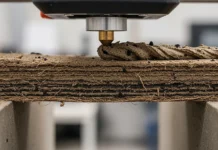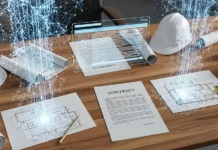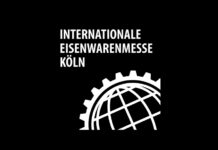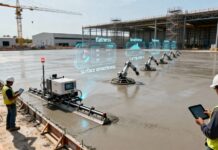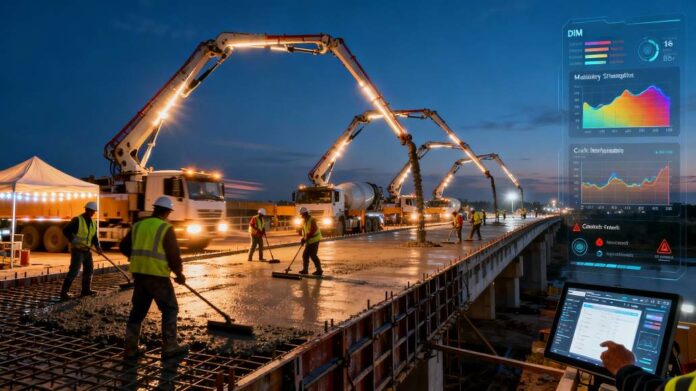Large-scale concrete pours represent some of construction’s most complex operations, involving coordination of hundreds of workers, sophisticated equipment, specialized materials, and precise sequencing to achieve successful completion. Continuous concrete placement operations for bridge decks, parking structures, or industrial foundations demand sustained coordination for hours or days, with quality outcomes depending on countless variables including concrete temperature, ambient conditions, placement rates, and compaction completeness. Traditionally, managers monitored progress through periodic site inspections, photograph documentation, and subjective assessments, discovering problems often long after they occurred when remediation became costly or impossible. Digital twin technology, combining real-time sensor data with advanced computational models and artificial intelligence analysis, transforms large-scale concrete pouring from uncertain operations relying on experience and intuition into data-driven processes where decision-making receives support from continuous, objective information about actual conditions and performance.
Understanding Digital Twin Technology and Its Core Capabilities
Digital twins represent dynamic virtual replicas of physical assets or systems, continuously updated with real-time data from sensors, monitoring equipment, and systems embedded throughout actual structures or operations. For concrete construction applications, digital twins integrate building information models establishing geometric and structural design parameters with real-time sensor data capturing actual concrete placement, curing, and performance characteristics. This integration creates living models that evolve continuously throughout construction phases, providing stakeholders with unprecedented visibility into actual project status and enabling predictive analytics identifying emerging problems before they manifest as visible defects.
The digital twin concept extends far beyond simple visualization tools or project monitoring dashboards. Sophisticated digital twins incorporate artificial intelligence algorithms that learn from accumulated data, identifying patterns correlating with successful or problematic outcomes. Machine learning models trained on historical project data develop predictive capabilities enabling forecasting of concrete strength development, identification of cracking risks, optimization of curing conditions, and detection of early-stage defects invisible to human observation. These capabilities transform construction management from reactive problem-solving toward proactive optimization strategies that prevent problems rather than responding after occurrence.
Building information modeling provides the foundational geometric and structural information essential for digital twin functionality in construction applications. BIM models define design intent including concrete placement sequences, structural reinforcement locations, formwork configurations, and acceptance criteria for completed work. When enriched with digital twin capabilities, BIM models become dynamic platforms continuously receiving and processing real-time information from construction sites. As-built conditions continuously update within BIM environments, creating comprehensive records of actual construction reality diverging from design intent when variations occur. This continuous comparison identifies deviations enabling rapid corrective action before problems compound.
Internet of Things sensor networks provide the real-time data streams sustaining digital twin functionality throughout concrete pours and subsequent curing phases. Embedded sensors monitor concrete temperature at multiple locations and depths, tracking heat generation from cement hydration and heat dissipation influenced by ambient conditions. Moisture sensors detect water content variations affecting concrete strength development and durability. Strength maturity sensors using electrical impedance or ultrasonic transmission measure concrete curing progress in real-time. Strain gauges detect structural stresses developing as concrete sets and bears applied loads. Collectively, these sensor arrays generate continuous data streams providing unprecedented insight into actual concrete behavior throughout curing and early service life.
Real-Time Concrete Pour Monitoring and Quality Assurance
During massive concrete placement operations, digital twin systems provide real-time monitoring of concrete temperature distribution, placement rates, and structural integrity development. Thousands of cubic meters of concrete placement over extended periods creates thermal gradients within masses of fresh concrete. Excessive temperature differentials between surface and interior regions create thermal stresses as differential cooling rates drive cracking in young concrete. Early-age cracking, while small in initial stages, creates pathways for water and chemical ingress accelerating long-term deterioration. Digital twin systems monitoring temperature gradients throughout pours alert operators when conditions approach critical thresholds, enabling interventions such as insulation adjustments, placement rate modifications, or ambient conditioning preventing problematic cracking development.
Real-time concrete strength development monitoring enables dynamic decision-making about formwork removal timing and loading progression. Traditional approaches rely on estimating strength development based on ambient temperature history and maturity calculations, introducing conservatism that delays schedule progression or risks inadequate strength when estimates prove inaccurate. Digital twin systems incorporating actual concrete strength measurement through wireless sensors provide objective information about actual strength development. When concrete achieves required strength values confirmed through real-time sensor data rather than calculations, formwork removal proceeds immediately rather than awaiting predetermined calendar intervals. This confidence-based approach compresses construction timelines while maintaining rigorous structural safety standards.
Quality control processes benefit enormously from continuous digital monitoring compared to traditional periodic testing approaches. Rather than removing samples for laboratory strength testing producing results days after placement, embedded sensors provide continuous strength data throughout curing. If curing conditions drift from optimal ranges, immediate intervention becomes possible before quality deteriorates beyond recovery. Concrete demonstrating anomalous strength development receives investigation and remediation attention immediately rather than discovering inadequacy during subsequent construction phases. This real-time quality assurance approach prevents defects rather than discovering them through later inspection.
Coordination among multiple trades and operations improves dramatically when real-time project status receives continuous updating through digital twin systems. Rather than relying on outdated progress reports or subjective site observations, all stakeholders access current information about concrete placement status, curing progress, and readiness for subsequent construction phases. When concrete reaches strength permitting formwork removal or loading progression, the system immediately alerts relevant teams enabling synchronized work progression. This continuous coordination reduces delays caused by one trade awaiting information about another’s progress.
Predictive Analytics and Proactive Problem Prevention
Beyond real-time monitoring, digital twin systems employ artificial intelligence and machine learning algorithms to develop predictive capabilities identifying emerging problems before they manifest visibly. By analyzing historical data from thousands of projects, algorithms learn patterns correlating particular conditions or situations with successful versus problematic outcomes. When current project conditions replicate patterns historically associated with problems, the system alerts project managers enabling preventive interventions. This predictive capability transforms management from reactive crisis response toward proactive problem prevention.
Thermal cracking prediction represents a valuable digital twin capability preventing one of concrete’s most common quality issues. Algorithms trained on projects experiencing or avoiding thermal cracking develop models identifying situation characteristics predicting cracking probability. When current pour conditions and environmental parameters approach predicted cracking risk thresholds, the system recommends interventions such as modified placement sequences, insulation adjustments, or ambient conditioning that reduce cracking probability. Early intervention proving successful prevents problems rather than discovering damage after concrete hardens.
Concrete strength development prediction enables optimization of construction schedules by identifying when concrete reaches required strength values allowing formwork removal or loading progression. Rather than waiting for predetermined calendar intervals or relying on maturity calculations introducing conservatism, algorithms trained on similar concrete formulations develop predictive models of actual strength development incorporating observed material characteristics and curing conditions. As real-time sensor data accumulates, strength development predictions become increasingly accurate. Construction teams confidently remove formwork or progress loading when predicted strength approaches desired levels, accelerating schedule without compromising safety.
Equipment and personnel optimization receives support from digital twin analytics identifying inefficient operations or resource allocation. Historical data comparing project productivity to parameters such as crew size, equipment deployment, material delivery timing, and weather conditions reveals patterns correlating with efficient operations. When current projects diverge from patterns historically associated with efficient productivity, the system alerts managers enabling corrective measures. Over time, project teams learn which operational approaches consistently produce desired efficiency outcomes, progressively refining approaches toward optimal performance.
Integration with Building Information Modeling Workflows
The relationship between digital twins and Building Information Modeling represents complementary rather than competitive capabilities. BIM establishes design foundation defining geometric and structural information essential for digital twin functionality. Digital twins enhance BIM capabilities through real-time data integration and continuous operational intelligence. The integration creates comprehensive platforms supporting design through construction through facility operation phases with consistent information environments.
Clash detection capabilities extend throughout construction when BIM models receive continuous updating with real-time as-built conditions. Rather than identifying conflicts only during design phases, ongoing clash detection identifies deviations between design intent and actual construction. When reinforcement placement, embedded utilities, or structural elements locate differently than designed, the system identifies conflicts enabling immediate correction before subsequent work proceeds based on incorrect assumptions. This continuous clash detection prevents costly rework and schedule delays from undiscovered construction conflicts.
Schedule optimization receiving input from real-time progress monitoring and predictive analytics enables dynamic refinement of construction sequences maximizing efficiency. Rather than rigid predetermined schedules, adaptive scheduling approaches adjust work sequences based on actual progress and predicted completion timing. When particular activities progress faster than anticipated, dependent activities can begin earlier than originally scheduled. When delays occur, adaptive scheduling identifies alternative sequences maintaining overall project progress. Digital twin systems providing real-time progress information and predictive completion estimates enable sophisticated scheduling optimization.
Material logistics optimization receives significant benefits from digital twin visibility into actual material consumption rates and just-in-time delivery optimization. Rather than pre-staging excessive material quantities creating storage and waste problems, precise delivery timing based on actual usage rates reduces site congestion and material waste. Digital twin systems tracking material usage and predicting near-term requirements generate delivery schedules ensuring material availability when needed while minimizing excess on-site storage.
Data Management and Information Architecture
Successful digital twin implementation requires robust data management infrastructure supporting continuous data inflow from multiple sensors, systems, and sources. Cloud-based platforms provide scalability and accessibility enabling remote monitoring and analysis from any location. Edge computing approaches processing data locally before cloud transmission reduce bandwidth requirements and enable faster real-time response. Hybrid approaches combining local processing with cloud analytics optimize performance for different application requirements.
Data quality and security represent critical considerations for digital twin systems. Sensor malfunctions producing erroneous data can mislead analysis and lead to inappropriate decisions. Redundant sensors in critical measurement locations and automated data validation algorithms detect and flag suspicious readings for manual verification. Cybersecurity measures protect sensitive project information and prevent unauthorized system access or data manipulation. Secure authentication, encryption of data transmission, and access controls ensure only authorized personnel access confidential project information.
Integration of digital twin systems with existing enterprise systems and databases enables comprehensive information environments supporting construction operations. When digital twin platforms connect with accounting systems, procurement management, equipment tracking, and other operational systems, comprehensive project visibility enables sophisticated optimization across multiple dimensions. Coordinated optimization of schedule, cost, quality, and resource utilization becomes feasible when information flows seamlessly among systems.
Data retention and lifecycle management ensure valuable historical information remains accessible for analysis and learning after projects conclude. By analyzing completed projects’ comprehensive performance data, future projects benefit from accumulated wisdom about approaches, conditions, and outcomes correlating with success. Machine learning algorithms trained on larger datasets develop increasingly sophisticated predictive models improving outcomes on future projects. Strategic data retention supporting organizational learning represents valuable infrastructure investment.
Future Developments and Technology Evolution
Advancing digital twin technology for concrete construction continues through improved sensors, artificial intelligence algorithms, and integration approaches. Next-generation sensors becoming smaller, more accurate, less expensive, and requiring less power enable denser monitoring networks generating richer data. Wireless power transfer technologies promise virtually unlimited sensor operational life eliminating battery replacement needs. Advanced materials research explores printable sensors and structural health monitoring capabilities embedded during concrete fabrication providing unprecedented monitoring density throughout concrete masses.
Artificial intelligence development continues advancing predictive capabilities and decision support. Deep learning algorithms processing massive datasets develop sophisticated models capturing complex relationships among variables. Natural language processing enables more intuitive human-system interaction, allowing operators to query digital twin systems using conversational language rather than formal command structures. Autonomous decision-making systems trusted with increasingly complex decisions reduce human workload while improving outcomes when properly trained and validated.
Integration with emerging technologies including augmented reality, autonomous robotics, and advanced drones creates opportunities for enhanced construction management. Augmented reality visualization overlaying digital twin information onto physical construction sites provides intuitive visibility into design intent, as-built conditions, and current status. Autonomous equipment coordinated through digital twin systems optimizes material delivery and equipment positioning. Drone monitoring provides aerial perspectives complementing ground-level sensor networks, creating comprehensive site awareness.
Standardization efforts establishing common data formats, sensor communication protocols, and information exchange standards will accelerate digital twin adoption by reducing proprietary system constraints. Open standards enabling interoperability among systems from different vendors promise increased competition and innovation. Industry-wide standardization of digital twin methodologies and best practices supports widespread adoption and knowledge sharing.
Digital twin technology represents transformative potential for large-scale concrete construction through continuous real-time monitoring, predictive analytics, and intelligent decision support. As technology matures and costs decline, digital twins transition from specialized implementations toward standard practice in major construction projects. The convergence of improved sensor technology, advanced artificial intelligence, and mature digital platforms creates opportunities for construction industries to achieve unprecedented quality, schedule adherence, cost control, and safety outcomes through data-driven management supported by sophisticated digital infrastructure.




